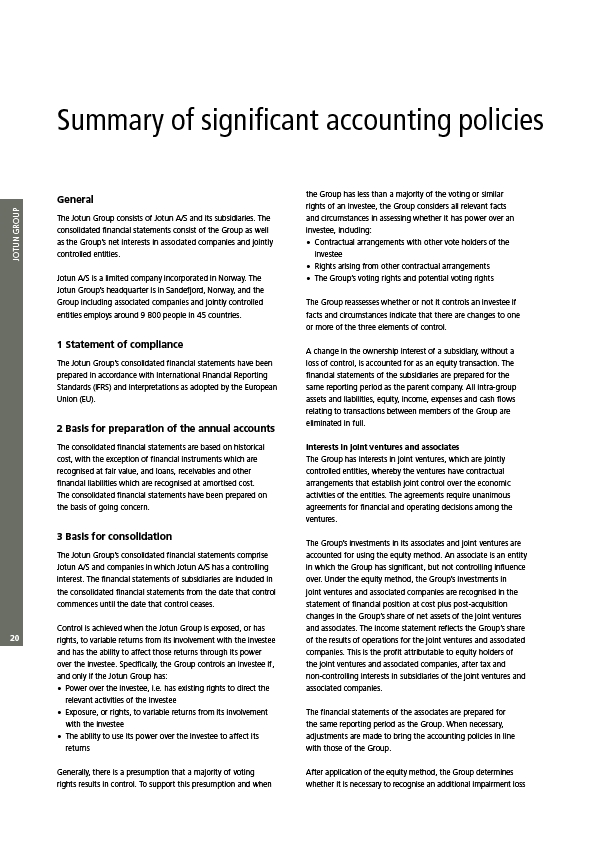
JOTUN GROUP
20
Summary of significant accounting policies
General
The Jotun Group consists of Jotun A/S and its subsidiaries. The
consolidated financial statements consist of the Group as well
as the Group’s net interests in associated companies and jointly
controlled entities.
Jotun A/S is a limited company incorporated in Norway. The
Jotun Group’s headquarter is in Sandefjord, Norway, and the
Group including associated companies and jointly controlled
entities employs around 9 800 people in 45 countries.
1 Statement of compliance
The Jotun Group’s consolidated financial statements have been
prepared in accordance with International Financial Reporting
Standards (IFRS) and interpretations as adopted by the European
Union (EU).
2 Basis for preparation of the annual accounts
The consolidated financial statements are based on historical
cost, with the exception of financial instruments which are
recognised at fair value, and loans, receivables and other
financial liabilities which are recognised at amortised cost.
The consolidated financial statements have been prepared on
the basis of going concern.
3 Basis for consolidation
The Jotun Group’s consolidated financial statements comprise
Jotun A/S and companies in which Jotun A/S has a controlling
interest. The financial statements of subsidiaries are included in
the consolidated financial statements from the date that control
commences until the date that control ceases.
Control is achieved when the Jotun Group is exposed, or has
rights, to variable returns from its involvement with the investee
and has the ability to affect those returns through its power
over the investee. Specifically, the Group controls an investee if,
and only if the Jotun Group has:
• Power over the investee, i.e. has existing rights to direct the
relevant activities of the investee
• Exposure, or rights, to variable returns from its involvement
with the investee
• The ability to use its power over the investee to affect its
returns
Generally, there is a presumption that a majority of voting
rights results in control. To support this presumption and when
the Group has less than a majority of the voting or similar
rights of an investee, the Group considers all relevant facts
and circumstances in assessing whether it has power over an
investee, including:
• Contractual arrangements with other vote holders of the
investee
• Rights arising from other contractual arrangements
• The Group’s voting rights and potential voting rights
The Group reassesses whether or not it controls an investee if
facts and circumstances indicate that there are changes to one
or more of the three elements of control.
A change in the ownership interest of a subsidiary, without a
loss of control, is accounted for as an equity transaction. The
financial statements of the subsidiaries are prepared for the
same reporting period as the parent company. All intra-group
assets and liabilities, equity, income, expenses and cash flows
relating to transactions between members of the Group are
eliminated in full.
Interests in joint ventures and associates
The Group has interests in joint ventures, which are jointly
controlled entities, whereby the ventures have contractual
arrangements that establish joint control over the economic
activities of the entities. The agreements require unanimous
agreements for financial and operating decisions among the
ventures.
The Group’s investments in its associates and joint ventures are
accounted for using the equity method. An associate is an entity
in which the Group has significant, but not controlling influence
over. Under the equity method, the Group’s investments in
joint ventures and associated companies are recognised in the
statement of financial position at cost plus post-acquisition
changes in the Group’s share of net assets of the joint ventures
and associates. The income statement reflects the Group’s share
of the results of operations for the joint ventures and associated
companies. This is the profit attributable to equity holders of
the joint ventures and associated companies, after tax and
non-controlling interests in subsidiaries of the joint ventures and
associated companies.
The financial statements of the associates are prepared for
the same reporting period as the Group. When necessary,
adjustments are made to bring the accounting policies in line
with those of the Group.
After application of the equity method, the Group determines
whether it is necessary to recognise an additional impairment loss